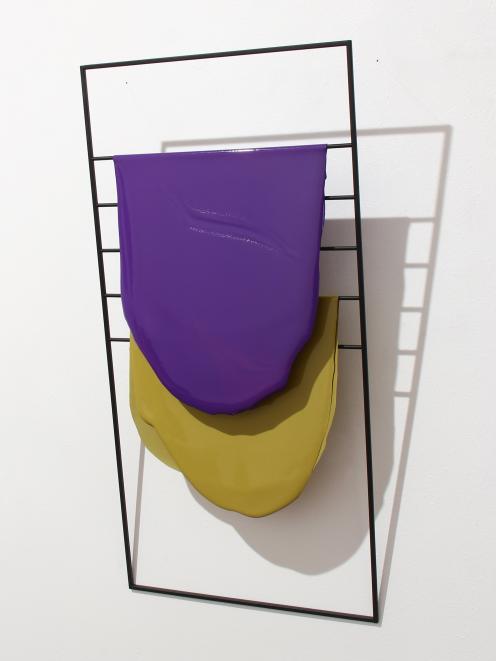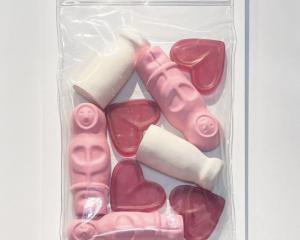In this week's Art Seen, Robyn Maree Pickens looks at exhibtions from Milford Gallery, Mint Gallery, and Campbell Paterson.
 Purple, Ochre (2016), by Helen Calder
''ModCon'' (Milford Gallery)
Purple, Ochre (2016), by Helen Calder
''ModCon'' (Milford Gallery)

ModCon can be regarded positively as two parallel exhibitions, or as one exhibition with two interrelated themes. The exhibition takes as its premise the 20th-century modernist movement, which privileged form for form's sake, and contemporary responses to modernism.
In ModCon, New Zealand's response to 20th-century modernism is represented by the abstract paintings of Gordon Walters and Mervyn Williams, both of whom use symmetry to animate the plane of the painting. For Williams and Ian Scott symmetry and colour relationships are deployed to create optical illusions of three-dimensional space with recessive and forward movements between foreground and background.
Where illusion and movement are contained or take place on the flat plane of the painting itself, contemporary artists included in ModCon such as Oliver Perkins and Helen Calder have dispensed with the restriction of the flat canvas. In different ways Perkins and Calder create works that hover between sculpture and painting.
Perkins stacks one canvas on another: here depth is actual not illusionistic. Calder isolates skeins of paint that traditionally would have adhered to the canvas: the pooled paint has become the ground, the picture plane.
Or almost, as skeins of paint are variously draped over steel supports with rungs, scrunched, or folded and layered on steel plinth-like structures. The various skein figurations pop in bursts of brilliantly shaped colour.
 Silent Order, 2017 by Mary McFarlane (foreground) and my masterpiece, 1992-2017 by James Robinson (background).
''Strata'', Mary McFarlane and James Robinson (Mint Gallery)
Silent Order, 2017 by Mary McFarlane (foreground) and my masterpiece, 1992-2017 by James Robinson (background).
''Strata'', Mary McFarlane and James Robinson (Mint Gallery)

Pairing works by Otago artists Mary McFarlane and James Robinson, Strata is one of the strongest curated exhibitions I have seen at Mint Gallery. McFarlane and Robinson's bodies of work complement each other, as the title Strata suggests, by accretion, by layers of meaning, and multiple cross references.
On one level both artists' work can be approached through an eco-critical or eco-philosophical lens: McFarlane for the collected concretions of shell and rock sediment she has joined to form shrine-like sculptures, and Robinson for drawings and text references to Donna Haraway's most recent eco-philosophical book Staying with the Trouble (2016).
Robinson's most impressive work consists of 44 rows of A4 drawings (one for each year of his life) that are seven A4 pages long (every seven years we are recomposed). Suspended from nails, the rows of drawings are variously hung flush with the wall or forward, which lends a sculptural quality to the installation.
In his trademark rough, sketchy, mixed media, self-interrogative style, Robinson's drawings and aphorisms cover every subject from globalised capitalism to ecological crisis, colonisation, spirituality, and the politics of self-construction.
McFarlane's sedimentary sculptures capture deep time. Various concretions hold fossils of crabs, small shells, empty pores that once contained tiny bones, and casts of evacuated sea creatures. McFarlane uses concrete to join the concretions in quietly elegiac forms.
 call sick 1, 2, 3, and 4 (2017), by Campbell Patterson
''call sick'', Campbell Patterson (Dunedin Public Art Gallery)
call sick 1, 2, 3, and 4 (2017), by Campbell Patterson
''call sick'', Campbell Patterson (Dunedin Public Art Gallery)

When Campbell Patterson's exhibition opened at the Dunedin Public Art Gallery on June 17, the Frances Hodgkins Fellow had been in Dunedin for approximately 20 weeks. This amount of time can be measured in track pants. Allow me to explain. Patterson is an artist who works with everyday situations, objects and time.
He takes an everyday object and propels it into a situation that he then makes strange. The object and the situation are further made uncanny with time, or the durational dimension of his performance-based practice.
The object in Patterson's exhibition centres on four pairs of track pants that are custom-made to giant proportions - perhaps the equivalent of 20XL. Each pair is propelled into a fairly quotidian situation: wearing them as pyjamas.
The now uncannily giant track pants as pyjamas, are made further strange by the durational constraint Patterson subsequently enacted, whereby each pair of track pants was worn each night for five weeks without a wash. They are still unwashed, and hang tendered for inspection in the gallery space adjacent to the ground floor lift.
Accompanying the track pants is a three-channel looped video in which a static camera captures Patterson as he repeatedly, and with exquisite difficulty, climbs repeatedly out of three separate windows wearing only a pair of giant grey track pants.\
-By Robyn Maree Pickens








![Untitled (c. mid 1990s, [pink 3]), by Martin Thompson, 415mm×590mm. Photo: courtesy of Brett...](https://www.odt.co.nz/sites/default/files/styles/odt_landscape_small_related_stories/public/story/2024/02/untitled_pink_3.jpg?itok=Q0aQrc9o)



